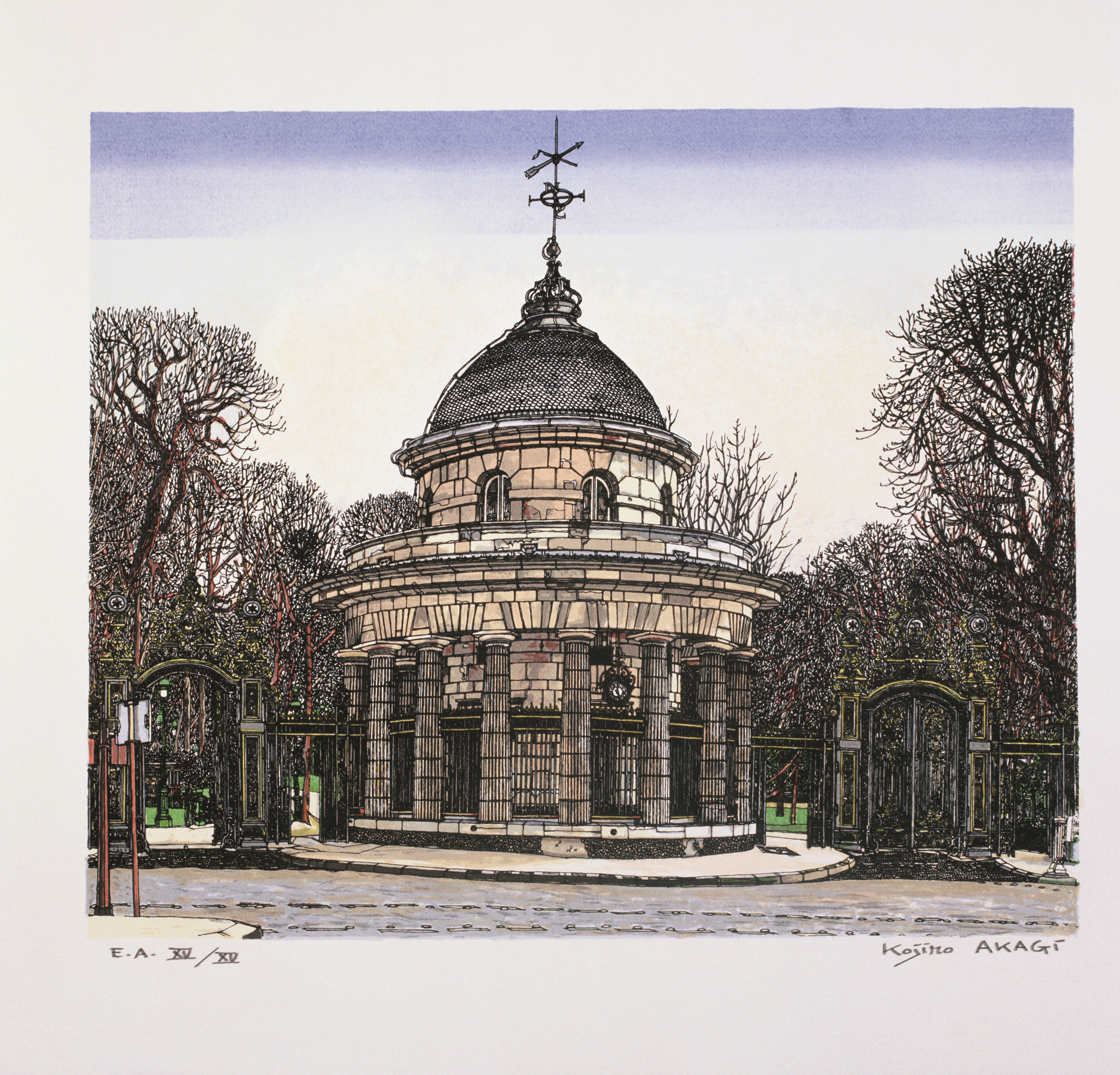La rotonde du Parc Monceau / The rotunda in Parc Monceau / モンソー公園のロトンド
Dublin Core
Title
La rotonde du Parc Monceau / The rotunda in Parc Monceau / モンソー公園のロトンド
Subject
Parc Monceau, Sérigraphie
Description
Le parc Monceau, entre le 17e et le 8e arrondissement, était un domaine aménagé en 1778 comme réserve de chasse pour le Duc d’Orléans. Quinze ans avant la Révolution française, ce quartier faisait partie de la ville de Paris, alors qu’avant ce n’était que la campagne où étaient organisées des parties de chasse. Ce bâtiment de forme cylindrique était, à l’origine, la Barrière de la rotonde de Chartres, construite entre 1784 à 1787. C’est un des exemples des nombreuses barrières d’octroi qui entouraient la ville de Paris et où l’on appliquait une taxe sur les produits importés. A cette époque, Paris appliquait un octroi sur tous les produits venant de l’extérieur de ses enceintes. Au 19e siècle, la ville couvrait ainsi jusqu’à 60 % de ses ressources financières. Avec le temps, l’octroi a perdu de sa crédibilité, il est devenu une pratique opportuniste sans trop de règles, mais son rôle a perduré jusqu’en août 1943 durant l’occupation allemande de la Seconde Guerre mondiale. Comme le coût de la vie était plus cher à Paris, la population sortait des enceintes pour aller boire à moindre coût. A partir d’avril 1954, l’octroi a été remplacé par la TVA dans tout le pays. On dit que les dernières traces de l’octroi sont les taxes d’aéroport.
Parc Monceau, in the boundary of the 8th and 17th arrondissements, was completed in 1778 in a garden of a hunting mansion of the Duc d’Orléans, a member of the French royal family. It was about 15 years before the French Revolution and this space was still open ground despite being in the city so they could enjoy hunting outdoors.This cylindrical building was one of those built from 1784 to 1787 surrounding the city whose purpose was the collection of the aforementioned octroi consumption tax at the gate of Chartres. The tax was imposed on every item which entered Paris and was said to constitute 60% of the entire revenue of the city in the 19th century. Though the octroi tax had become haphazard and nominal in the end, it existed until August 1943 under the German occupation, so goods were more expensive within the city than without. Workers departed the city through the gates to drink more cheaply. It has now changed and the nationwide TVA value-added tax started from April 1954. The tax imposed at airports today is said to be a legacy of the octroi revenue system.
八区と十七区の境にあるモンソー公園は、フランス王家オルレアン公爵の狩用屋敷の庭で、一七七八年に出来上がった。フランス革命の十五年ほど前だが、このあたりは市内といっても、まだ野原や空き地で、外に向けて狩も楽しめたのである。この円筒形の建物は、有名な一七八四年から八七年に掛けてパリ市を取り囲んで建てた、物品入市税徴収障壁の、シャルトル門の税金徴収所の建物だった。消費税を、パリ市内に入る品物には全て掛けて、十九世紀には市収入の、六〇%を占めるとまで言われた、財源だったのである。入市税は、最後は行き当たりばったりの有名無実になっていたとはいっても、第二次大戦中ドイツ占領下の一九四三年八月までパリ市に存在していて、その分だけ市内では割高なわけで、庶民は市門の外に、安く呑みに出掛けたのであった。今では変わってTVA付加価値税(消費税)が一九五四年四月から、全国すべてに始まった。現代までも残っている入市税の名残りが、空港税だといわれる。
Creator
Kojiro Akagi (1934-2021)
Date
Mai 1981, May 1981
Rights
Fonds de dotation Kojiro AKAGI
Format
Sérigraphie, Atelier Del Arco, 100 tirages + 15 E.A. romain,
sur papier Arches 49,5 x 65 cm.
sur papier Arches 49,5 x 65 cm.
Type
Sérigraphie
Tags
Citation
Kojiro Akagi (1934-2021), “La rotonde du Parc Monceau / The rotunda in Parc Monceau / モンソー公園のロトンド,” Kojiro Akagi - Fonds de dotation Kojiro AKAGI , accessed January 7, 2026, https://kojiroakagi.com/gallery/items/show/125.

